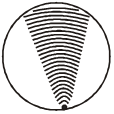- Books Name
- CBSE Class 7 Mathematics Book
- Publication
- Param Publication
- Course
- CBSE Class 7
- Subject
- Mathmatics
INTRODUCTION
The figures such as triangles, rectangle, squares, circles etc. which have only two dimensions, namely length and breadth are called plane figures or 2-dimensional figures.

The figure such as cube, cuboid, cylinder, pyramid etc. which have three dimensions namely length, breadth & height are called solid figures or 3-dimensional figures.

Types of Solid
There are mainly three types of solids :
(1) Prism : A solid whose top and base are identical polygons and side faces are rectangles, is called a prism. In a square prism whose top and base are congruent squares.

(2) Pyramid : A solid whose side faces are triangles and base is any polygon is called a pyramid. Figure shows a pentagonal pyramid.

(3) Sphere : Sphere is a solid whose every point is equidistant from a fixed point. Figure shows the sphere.

Note : (i) All the side faces of a pyramid (squares, rectangular, triangular, pentagonal etc.) are triangular.
(ii) A pyramid is named according to the shape of its non-triangular face. If all the faces are triangular, then it is called a triangular pyramid or tetrahedron.
- Books Name
- class 7 Mathematics Book
- Publication
- ReginaTagebücher
- Course
- CBSE Class 7
- Subject
- Mathmatics
Chapter -15
Visualizing Solid Shapes
Measurement of the shapes from a certain angle or direction is called dimension.
The closed figures drawn on a flat-surface or on a plane are two-dimensional shapes. The sides of these shapes can contain straight or curved surfaces. The shapes can have 'n' number of sides.
2-D shapes are also called as plane figures
Three-dimensional shapes
Our entire world is made up of objects that occupy space. Any object or a shape that occupies space is three-dimensional.
The 3-D figures are also called as solid figures.
The flat surface of a solid shape is its face. A solid shape can have 'n' number of faces.
The line segment on a solid shape is called an edge.
The point where two or more edges join is a corner or vertex of a solid shape.
Oblique sketching is a pictorial representation of an object, in which the diagram is intended to depict the perspective of objects in three dimensions.
Isometric sketch is similar to oblique sketching but the solid figure is represented on an isometric sheet.
An isometric sheet will have dots in small equilateral triangles all over the sheet. The distance between each dot in the graph is usually considered as scale of 1cm.
A cross-section is the new face of the object we get when we slice the object from any direction. The newly formed face will always resemble a two-dimensional shape.
Shadow play is one of the ways of viewing solids. When light falls on an object, the resultant shadow thus formed is two-dimensional.

 Param Publication
Param Publication
 ReginaTagebücher
ReginaTagebücher
